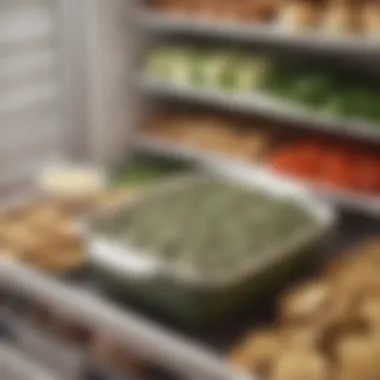Shelf Life of Spinach Dip: Storage and Safety Insights


Intro
Spinach dip, a favorite among many, often finds its way to gatherings and cozy dinners alike. Understanding its shelf life and proper storage is vital to ensure safety and enjoyment. Many food lovers may not realize that improper storage can lead to spoilage, making the dip unsafe for consumption. This article aims to clarify essential points about spinach dip storage, signs of spoilage, and best practices for prolonging its freshness. By mastering these aspects, consumers can engage confidently with this delightful dish while minimizing food waste.
Recipe Overview
Recipe Name
Spinach Artichoke Dip
Description of the Dish
Spinach artichoke dip is a creamy blend showcasing spinach and artichokes, often baked to a bubbling finish. It serves as a perfect appetizer, pairing well with crusty bread, tortilla chips, or fresh vegetables. This dish balances flavors, offering a rich and savory experience. Seasonal variations may include the addition of cheeses or herbs, enhancing its appeal.
Ingredients
- Spinach (fresh or frozen, about 10 oz)
- Artichoke hearts (canned or frozen, roughly 14 oz)
- Cream cheese (8 oz)
- Sour cream (1 cup)
- Mayonnaise (1/2 cup)
- Parmesan cheese (1/2 cup, grated)
- Garlic (2 cloves, minced)
- Salt (to taste)
- Pepper (to taste)
Special Notes on Ingredients
- For a lighter version, substitute sour cream with Greek yogurt.
- If fresh spinach is unavailable, frozen spinach is a suitable alternative but ensure to drain excess water.
- Different varieties of cheese can be used for unique flavors, such as mozzarella or cheddar.
Understanding the right ingredients and their storage plays a critical role in maintaining the freshness of spinach dip. Familiarity with these points contributes to the overall culinary experience, allowing for safe and enjoyable servings.
Prolusion to Spinach Dip
Spinach dip is a beloved dish often found at gatherings, parties, and potlucks. Understanding this dish starts with its fundamental components and the reasons behind its popularity. This section offers insights that set the stage for discussing storage and safety aspects.
Definition and Ingredients
Spinach dip is primarily a creamy blend featuring spinach and various other ingredients. Common components include cream cheese, sour cream, mayonnaise, and spices. Depending on the recipe, one might also find cheese, garlic, and various herbs. This versatility allows for numerous variations, catering to different tastes and dietary preferences. Properly defined, spinach dip serves as a flavorful addition to any appetizer spread. Knowing the core ingredients becomes essential in understanding its shelf life.
Popularity and Variations
The appeal of spinach dip lies not only in its taste but also in its adaptability. Spinach dip can be served raw with vegetables, baked with a crispy top, or even blended into a smoother texture. Some popular variations include artichoke and spinach dip, which incorporates artichoke hearts, and spicy versions, often featuring jalapeños or hot sauce.
Spinach dip has transcended cultural boundaries, becoming a staple in many households. It's often associated with comfort food, making it a favorite during social events. People appreciate its ability to blend well with a variety of dippers, from chips to bread. This broad acceptance highlights the dish's role in fostering conversations and community. The importance of understanding spinach dip extends beyond simply enjoying the dish; it also encompasses the necessary practices to ensure it remains safe for consumption.
Understanding Shelf Life
Understanding the shelf life of spinach dip is crucial for ensuring food safety and maintaining flavor quality. Knowing how long spinach dip lasts can prevent food waste and potential health risks. Each element related to shelf life carries a specific importance that can affect the overall experience of enjoying this popular dish. This section will explore the concept of shelf life, the factors that influence it, and practical implications for storage.


What is Shelf Life?
Shelf life refers to the length of time that a food product remains safe to consume while retaining its intended flavor and quality. For spinach dip, this duration can vary widely based on several factors, such as ingredients and storage methods. Generally, spinach dip can be expected to last several days to weeks when stored properly. Beyond this timeline, the risk of spoilage increases significantly. Understanding shelf life helps consumers make informed decisions about how long they can keep the dip before it is no longer safe to eat.
Factors Affecting Shelf Life
Ingredients Used
The composition of spinach dip plays a central role in determining its shelf life. Ingredients like cream cheese, sour cream, and spinach each have unique properties that impact freshness. For instance, cream cheese is prone to spoilage if left unrefrigerated for extended periods. Conversely, spinach itself contains moisture, which can promote bacterial growth if not stored correctly. By selecting high-quality, fresh ingredients, you ensure that the dip remains safe and delicious for an extended time. Therefore, the combination of ingredients not only influences flavor but also shelf stability.
Preparation Method
The way spinach dip is prepared can significantly affect its longevity. For example, thoroughly cooking the spinach before mixing it with other ingredients can help eliminate certain bacteria that might lead to spoilage. Additionally, avoiding cross-contamination during preparation is essential. Using clean utensils and storage containers minimize the risk of introducing harmful pathogens. Each method has distinct features that can either enhance or reduce the dip's overall shelf life. Understanding these methods contributes to making spinach dip safer and more enjoyable.
Storage Conditions
How spinach dip is stored after preparation has a direct relationship with its shelf life. Refrigeration is essential for prolonging the freshness of spinach dip. Ideally, it should be stored in an airtight container to limit exposure to air and moisture, which can speed up spoilage. Alternatively, freezing the dip can extend its shelf life considerably, preserving flavor and texture effectively. However, thawing can impact the quality, so it should be done carefully. By adhering to proper storage techniques, one not only maintains freshness but also optimizes the enjoyment of the dip for later use.
Proper storage practices contribute significantly to extending the life of spinach dip, helping to reduce waste and enhance culinary experiences.
Spinach Dip Storage Guidelines
Understanding how to store spinach dip properly is crucial for maintaining its quality, flavor, and safety. Spinach dip, whether homemade or store-bought, can easily spoil if not handled correctly. This section outlines two primary methods: refrigeration and freezing. Each method has specific practices that can help prolong the life of your dip. By following these guidelines, not only can you enjoy your spinach dip for a longer period, but you also contribute to reducing food waste and ensuring that every serving is as fresh as possible.
Refrigeration Practices
Storing spinach dip in the refrigerator is a common method that suits short-term storage needs. The primary benefit of refrigeration is that it slows down the growth of bacteria while keeping the dip flavorful and fresh. When utilizing refrigeration, there are several practices to consider:
- Temperature Control: Ensure your refrigerator is set at or below 40°F (4°C). This temperature helps maintain safety and quality.
- Container Selection: Use airtight containers to keep out moisture and prevent the dip from absorbing other odors in the fridge. Glass or sturdy plastic containers with tight-fitting lids are excellent choices.
- Shelf Placement: Store the dip on a shelf inside the refrigerator rather than in the door. The interior maintains a more consistent temperature compared to the door.
- Storage Duration: Generally, refrigerating spinach dip allows for a consumption window of 3 to 5 days. If you notice any changes in texture or aroma, it's wise to discard the dip to avoid health risks.
Following these practices enhances the possibility of your spinach dip remaining safe and delicious during its time in your fridge.
Freezing Spinach Dip
Freezing is an excellent method for extending the shelf life of spinach dip, especially if you have made a large batch or need to save leftovers for a later date. Freezing can effectively preserve flavor and nutrients. To maximize the benefits of freezing, keep these considerations in mind:
- Preparation for Freezing: Before freezing, allow the dip to cool completely if it was heated. This prevents excess moisture from forming in the container, which can affect the dip's quality.
- Container Use: Use freezer-safe containers or heavy-duty freezer bags. Remove as much air as possible to avoid freezer burn. If using bags, lay them flat in the freezer for easier storage.
- Freezing Duration: Spinach dip can last up to 3 months in the freezer. After this time, it may still be safe to eat, but the quality might decline.
- Thawing Process: To enjoy frozen spinach dip, thaw it overnight in the refrigerator. Do not thaw at room temperature, as this could allow bacteria to grow.
"Proper storage practices ensure that your meals remain safe and enjoyable, allowing for greater flexibility in your cooking and eating habits."
By understanding and implementing effective storage methods like refrigeration and freezing, you not only maximize the life of your spinach dip but also appreciate it even more when the time comes to serve it.


How Long is Spinach Dip Good For?
Understanding how long spinach dip is good for is essential for both food safety and enjoyment. Misestimating its shelf life can lead to either waste or, worse, health risks. By knowing the right timeframes, users can effectively plan their meals and utilize leftovers properly. This section aims to clarify the expected duration spinach dip remains safe to consume and the variables that can alter its shelf life. Proper knowledge helps in reducing food waste and promotes culinary satisfaction.
General Timeframes
The longevity of spinach dip relies on various factors, including preparation methods and storage conditions. Generally, spinach dip can last:
- In the fridge: Freshly prepared spinach dip usually remains good for about 3 to 5 days. This timeframe applies to any dip that contains typical ingredients such as sour cream or cream cheese.
- In the freezer: When sealed properly, spinach dip can last for about 2 to 3 months in the freezer. However, the texture may change upon thawing, affecting the overall eating experience.
It is crucial to always check the packaging or any guidelines provided with commercial spinach dips. Often, they come with a
Signs of Spoilage
Understanding the signs of spoilage is essential for anyone who enjoys spinach dip. Spoilage not only affects the flavor and texture of the dip, but it also poses safety risks. Recognizing these indicators helps prevent foodborne illnesses and wasted ingredients. When spinach dip has gone bad, it can lead to unpleasant experiences, ruining what should be a flavorful treat. By learning to identify spoilage signs, you ensure the quality and safety of your dish.
Visual Indicators
Visual indicators are often the first clues that spinach dip may have spoiled. Color changes are significant; fresh spinach dip typically has a vibrant green hue. If the dip appears dull, brown, or has any discoloration, it could mean spoilage is setting in. Additionally, separation of ingredients may become noticeable. If the creamy texture begins to break apart or if liquid collects on top, it’s a strong signal that freshness has deteriorated.
Mold is another important visual sign to check for. If you spot any fuzzy growths or unusual spots on the surface, discard the dip immediately, as this indicates significant spoilage. It is critical to be observant and not overlook minor changes that can lead to food safety concerns.
Smell and Taste Changes
Alongside visual cues, olfactory and gustatory changes are significant. The smell of spinach dip should be fresh and earthy, with a hint of creaminess from the common ingredients like sour cream or yogurt. A sour or off-putting odor is a red flag. If the aroma becomes unpleasant or distinctly different, it is best to err on the side of caution.
Taste testing is another method to check freshness. If you taste the dip and it has a strange, off flavor, it is an indication that spoilage has occurred. A change in taste can be subtle at first, but if it is noticeably different from when the dip was freshly prepared or opened, it’s advisable not to consume the dip. Trust your senses; if something seems off, it’s safer to throw it out to avoid any health risks.
Recognizing spoilage signs can save you from health issues and enhance your culinary enjoyment.
Best Practices for Reducing Waste
Reducing waste is essential not only for the environment but also for improving your culinary experiences. Implementing best practices when handling spinach dip can greatly contribute to minimizing the amount of food thrown away. It allows consumers to relish in the rich flavors of this dish while also being responsible. Key elements of waste reduction include portion control and effective labeling and dating of containers. These practices help in maintaining freshness and reducing indecision about disposing of food items.
Portion Control
Portion control is critical in ensuring that food is consumed before it has a chance to spoil. When hosting gatherings or preparing meals, it’s often tempting to make a large batch of spinach dip. However, over-preparing can lead to unwanted leftovers, which may end up being wasted if not stored correctly. To tackle this issue, consider the following strategies:
- Assess your audience: Understand how many people you are serving. This insight helps determine the right amount of dip, preventing an excess that may spoil.
- Use smaller serving bowls: Presenting spinach dip in smaller containers encourages moderation. Guests can easily take a small portion, and any remaining dip in the main container stays sealed, minimizing exposure to air, which accelerates spoilage.
- Freeze extra portions: If you do create extra spinach dip, freezing it in small portions can help extend its shelf life. This method allows you to enjoy your dip later on, without wasting any.
By carefully controlling portions, both during preparation and serving, you can significantly reduce the risk of waste.


Labeling and Dating Containers
In the realm of food safety, labeling and dating containers is an often overlooked practice. Properly labeling your spinach dip can provide you with critical information about freshness and safety. Here are some key practices:
- Clearly label all containers: Write the name of the dip and the date of storage on each container. This simple step reduces confusion and helps you track how long the spinach dip has been stored.
- Use a date format: Adopt an easy-to-read date format, such as MM/DD/YYYY. This clarity ensures that anyone handling the dip can quickly determine its freshness.
- Make it a habit: Develop a routine of labeling when preparing dishes. Regularly practice this while cooking not only applies to spinach dip but to other leftovers as well. This habit helps you stay organized in the kitchen.
Effective labeling and dating can help ensure that your spinach dip is consumed at its peak freshness, reducing the likelihood of waste.
Overall, best practices for reducing food waste are crucial when it comes to spinach dip. By controlling portions and practicing thoughtful labeling, you can contribute to a more sustainable kitchen and enjoy every bite of your delicious dip.
After Storage: What’s Next?
Understanding what to do after storing spinach dip is crucial for maintaining its quality and safety. After you have properly stored your dip, the next steps often involve reheating or finding creative ways to repurpose any leftovers. Proper handling ensures that the flavors remain intact, and the quality is preserved for future enjoyment.
Reheating Methods
Reheating spinach dip requires careful consideration to prevent compromising its texture and flavor. Here are some effective methods:
- Microwave: Place the dip in a microwave-safe container. Heat it on medium power in short bursts, stirring regularly. This helps achieve uniform heating without overheating any parts.
- Oven: Preheat your oven to 350°F (175°C). Transfer the dip to an oven-safe dish, cover with foil to retain moisture, and heat for about 15-20 minutes. Check periodically to avoid burning.
- Stovetop: Heat the dip in a saucepan over low to medium heat. Stir frequently to ensure even warming. Add a splash of milk or cream if it feels too thick while reheating.
Using these methods, you can ensure that your spinach dip retains its taste and texture. Be cautious not to overheat, as this can lead to separation of ingredients or dryness.
Creative Ways to Use Leftovers
Finding innovative uses for leftover spinach dip can enhance meal variety and reduce waste. Here are some suggestions:
- Spread on Sandwiches or Wraps: Use spinach dip as a flavorful spread for sandwiches or wraps. It adds a creamy texture and a burst of flavor.
- Pasta Sauce: Mix the leftover dip with cooked pasta for a delicious sauce. A splash of the pasta cooking water can assist in achieving a smoother consistency.
- Stuffed Peppers: Stuff halved bell peppers with spinach dip. Bake until the peppers are tender and heated through for a nourishing dish.
- Savory Bake: Incorporate spinach dip into a quiche or frittata mixture. This enhances the dish while providing extra nutrition.
- Dips for Veggies: Serve the dip alongside assorted vegetables for a healthy snack option. It pairs well with carrots, celery, and bell peppers.
These methods not only help in utilizing the leftovers effectively but also offer variety, making sure that none of the delicious dip goes to waste.
Utilizing leftovers creatively is not only practical but also enhances your culinary experience.
By understanding these post-storage methods, you can enjoy spinach dip to its fullest potential while encouraging mindful cooking and reducing food waste.
End
Understanding the shelf life of spinach dip is crucial for anyone who enjoys this versatile dish. The insights shared throughout this article emphasize the importance of proper storage practices, recognizing spoilage, and knowing how long spinach dip can last in various conditions. With the right approach, food lovers can minimize waste and ensure they enjoy spinach dip at its peak freshness. Proper storage not only maintains the flavor and texture of the dip but also prioritizes food safety, preventing any health risks associated with consuming spoiled food.
Summary of Key Points
In examining the storage and safety of spinach dip, several key points emerged:
- Shelf Life: The general shelf life varies based on factors such as ingredients, preparation methods, and storage conditions. Refrigeration and freezing can significantly prolong the freshness of the dip.
- Signs of Spoilage: Visual cues, such as discoloration, off-smells, and changes in texture are indicators that the dip may no longer be safe to consume.
- Storage Techniques: Proper refrigeration and freezing techniques, as well as portion control and labeling, help manage leftovers effectively.
Encouragement to Experiment
As we conclude, it is important to foster a spirit of experimentation in the kitchen. Spinach dip is more than just a standalone dish; it can be a canvas for creativity. From adjusting flavors to trying new ingredients, exploring variations can enhance your culinary repertoire. Whether it’s incorporating different cheeses, spices, or even adding other vegetables, there is a world of possibilities awaiting. Moreover, understanding storage and safety will empower you to try new combinations while minimizing waste. So go ahead, be bold in your kitchen endeavors, and relish the delightful experiences that spinach dip can bring!







